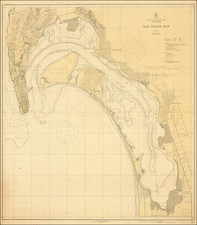Draft Neighborhood Plan for Petco Park / Ballpark District
This present example is a draft presentation storyboard which includes the original artwork (photograph of a 3-dimensional model) for the area around the future Petco Park, dated June 8, 1999, prepared by ROMA Design Group.
The present image illustrates the planning process for the presentation of the neighborhood plan for the area around the future Petco Park. A 3-dimensional model of the ballpark created by ROMA Design Group had previously been unveiled by the Padres on February 15, 1999. Following the unveiling of the ballpark model (illustrated at the center of the photo), ROMA prepared the present draft, which illustrates the proposed ballpark neighborhood (with ballpark at the center), including a model of a 33-story hotel and tower to be built just west of the ballpark, connected by a sky bridge over Seventh Avenue. The present draft is dated June 8, 1999, 2 months prior to the unveiling of the actual neighborhood plan on August 4, 1999.
The present plan is a rare artifact of planning process of San Diego's most significant downtown urban redevelopment project. Our search of the internet for other images of the development and design process did not reveal any other images of the original 3-dimensional planning model for the ballpark or neighborhood.
History of the San Diego Ballpark Neighborhood Project / Petco Park
The history of the Ballpark Neighborhood unfolded over a period of 6 years between 1994 and 2000. The following summarizes the major events:
- New Club Ownership
In December 1994, the San Diego Padres were acquired by John Moores, a Texas entrepreneur, philanthropist, and avid baseball fan, for a reported $80 million. This acquisition marked a pivotal moment for the club, as Moores, alongside his partner Larry Lucchino, sought to secure a new ballpark for the Padres. Lucchino, formerly the president and CEO of the Baltimore Orioles, was credited with developing Oriole Park at Camden Yards, the first of the "retro" ballparks with old-fashioned charm. Moores and Lucchino envisioned a state-of-the-art ballpark that would sustain major-league baseball in San Diego and enhance the city’s urban landscape.
- Community and City Involvement
The initial push for a new ballpark began with the San Diego International Sports Council’s report released on May 10, 1996, which explored stadium and arena financing options. This effort was followed by the establishment of the Mayor’s Task Force on Padres Planning, chaired by Ron Fowler. The task force’s final report, submitted to the City Council in September 1997, emphasized the Padres' significant economic impact on the San Diego/Tijuana region and the necessity of a community partnership to ensure the franchise’s long-term viability. The task force highlighted the trend towards baseball-oriented facilities and identified the potential for a new ballpark to revitalize a section of the city, integrating seamlessly with San Diego’s unique character and enhancing its economic activity.
- City of San Diego Task Force on Ballpark Planning
Following the initial task force report, the City Council approved Mayor Susan Golding’s proposal to form the City of San Diego Citizens Task Force on Ballpark Planning. This new task force, chaired by Patrick Shea, focused on selecting an optimal site for the ballpark, developing a viable financing plan, and creating a detailed design and construction timetable. City Councilman Byron Wear was appointed an ex-officio member. The task force evaluated five potential sites, ultimately recommending the East Village (Historic Warehouse District) due to its proximity to the Gaslamp Quarter and potential for stimulating economic development.
The task force’s recommendations included the creation of a Ballpark District and ensuring the public financing plan was fair and justified. The envisioned ballpark would serve as a catalyst for neighborhood revitalization, blending into the downtown skyline and expressing San Diego’s coastal and semi-arid character through its design.
- Design and Construction Teams
Prior to the task force's final report, the Padres had already assembled an architectural team comprising design architect Antoine Predock, executive architect Joe Spear from HOK + Venue + Event, and master plan architect Boris Dramov from ROMA Design Group. In June 1998, the team unveiled renderings of the proposed ballpark. A notable design element was the incorporation of the historic Western Metal Supply Company building, which set the left-field foul pole and added a unique touch reminiscent of Camden Yards in Baltimore.
The construction team, Ballpark Builders, was formed as a joint venture of Clark Construction Group, Inc., Nielsen Dillingham Builders, and Barnhart PCL. Hines Interests Limited Partnership was retained as the construction manager.
- Memorandum of Understanding and Proposition C
The Padres, in collaboration with the city, City Redevelopment Agency, and CCDC, developed a Memorandum of Understanding (MOU) outlining responsibilities and funding for the ballpark project. The estimated cost of $452.6 million was to be covered by the city, the Redevelopment Agency, private sources, and the Port of San Diego. The MOU was approved by voters through Proposition C on November 3, 1998, receiving 59.64 percent approval in a citywide election.
- Early Progress and Litigation
Construction officially commenced in May 2000, but was soon halted due to ongoing litigation led by former City Councilman Bruce Henderson and other opponents who questioned the public investment's justification and legality. These lawsuits resulted in a 16-month delay, during which significant progress was made, including the delivery of structural steel from Korea. The legal challenges were resolved in January 2002, allowing construction to resume and ensuring the project stayed on track.
Throughout the project, the Padres maintained public support through strategic outreach and events, such as the unveiling of ballpark renderings and the implosion of existing buildings. Key public events included:
- June 8, 1998: Unveiling of the first renderings of “A Ballpark for San Diego.”
- February 15, 1999: Unveiling of a scale model of the ballpark.
- August 4, 1999: JMI presentation of design plans for a 33-story hotel and tower connected by a sky bridge over Seventh Avenue.
- February 12, 2000: Symbolic right-field foul pole ceremony with San Diego native Ted Williams.
- April 1, 2000: “Ballpark Blast I,” the implosion of the former San Diego Gas and Electric building.
- August 12, 2000: “Ballpark Blast II,” the implosion of the last building in the ballpark footprint.
- Historic Preservation
The ballpark project included significant historic preservation efforts. Concerns were raised by the National Trust for Historic Preservation and the Save Our Heritage Organization. The Padres, JMI, and the city developed a comprehensive agreement to preserve 11 historic buildings within the Ballpark District, including the relocation of the Showley Brothers Candy Factory and Rosario Hall.
Conclusion
The present storyboard is a rare surviving artifact of the creation and approval of the ballpark neighborhood around San Diego's Petco Park.









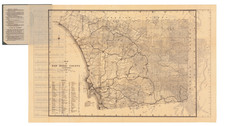
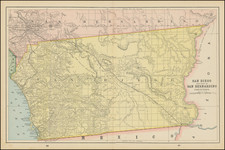
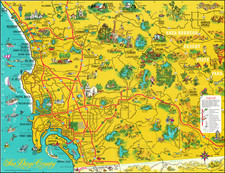
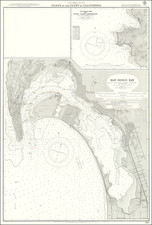
![[Oceanside and Camp Pendleton]](https://storage.googleapis.com/raremaps/img/small/71834.jpg)
